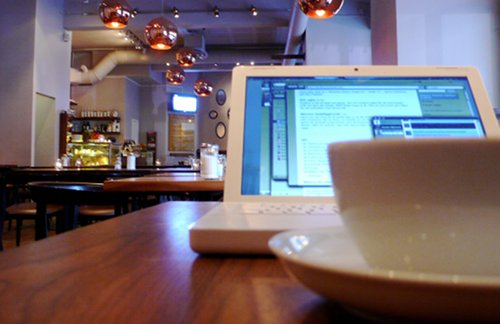Blog posts tagged Mobile working
IT for donuts: what's the best mobile device for working on?
IT for donuts is our regular Friday feature where we explain a tech term or answer a question about business IT. This week, find out which sort of mobile device is best for working on the move.
There are lots of different ways to work on the move. But there are only three main types of mobile device that you can work on. Each is good in different situations, so here's our guide to when and where each is best.
1. A smart phone
 Smart phones are small but powerful. You can slip one in your pocket to get online anywhere.
Smart phones are small but powerful. You can slip one in your pocket to get online anywhere.
Because they're always switched on and to hand, smart phones are great when you need to look up information in a hurry.
However, a small screen size makes them less-than-ideal for extended use or working on documents.
- Good for: sending and receiving email, checking social media, viewing maps, looking up information online and getting on the internet when space is tight (like crowded trains).
- Not so good for: working on documents or using for extended periods.
- Use when: you're out and about and just can't wait to perform a task online. Smart phones are best carried at all times and used on the hoof.
- Secret weapon: powerful smart phone apps enable you to extend the capabilities of your device. For instance, you may be able to send invoices on the go.
2. A tablet computer
 These touch screen devices have no keyboard, but are small enough to carry in your bag all day. They provide a good compromise between the portability of a smart phone and the power of a laptop.
These touch screen devices have no keyboard, but are small enough to carry in your bag all day. They provide a good compromise between the portability of a smart phone and the power of a laptop.
- Good for: sending and receiving email, social media, viewing websites, watching video and doing tasks that don't require much typing.
- Not so good for: anything that requires lots of typing or precise mouse work (there's no keyboard or proper mouse).
- Use when: you need to catch up on work between meetings or on a journey. Tablets can be used comfortably for a few hours at a time and have big, bright screens for reading and reviewing documents.
- Secret weapon: connect a portable keyboard to make writing and editing documents much easier.
3. A laptop
 Nothing beats a laptop when it comes to capabilities, because it's a full-on computer that you can use to run all your usual software. Microsoft Word, Excel ... they're all there to use on the go.
Nothing beats a laptop when it comes to capabilities, because it's a full-on computer that you can use to run all your usual software. Microsoft Word, Excel ... they're all there to use on the go.
However, laptops are heavier than other options and tend to have worse battery life.
- Good for: doing everything you do in the office — like working on documents, presentations and spreadsheets.
- Not so good for: instant internet access (you have to wait while it boots up), working in tight spaces, carrying on the off-chance you'll have ten minutes to fill with work.
- Use when: you're going to be away from the office for a while and will have a desk or table to work on.
- Secret weapon: you can use a laptop as your main business computer too. Just plug it into a separate screen, keyboard and mouse when you're at your desk.
Already have a laptop?
Many people already have laptops for business use — and companies are increasingly issuing them to employees as standard.
If you're happy carrying your laptop when you need to work on the move for extended periods, a smart phone should be your other device. It's ideal for getting online in a hurry to look up information or check your email.
In this sort of situation it's harder to justify a tablet computer too.
However, if you have a main desktop computer back at base then a tablet is a great mobile option — especially if you want a device you can carry 'just in case' you decide to get some work done.
Do you have a 'worliday' mentality?

Nobody ever works like this on their holiday.
Having just returned from a holiday during which my smart phone and laptop accompanied me, it's interesting to read research that says nearly two-thirds of British small business owners are likely to use their mobile devices for work purposes when off work.
The research, carried out by YouGov on behalf of FreeAgent, found 62% of people who run small businesses with five or fewer employees are either 'very likely' or 'fairly likely' to access their mobile devices for work when they take time off.
FreeAgent reckons the results may suggest small business owners are increasingly adopting a 'worliday' mentality, where they combine work and vacation to keep in touch with important aspects of their business. (It's unclear why they've adopted the horrendous portmanteau of 'worliday' — I prefer the much more elegant 'holidork'.)
Freelancers are always on duty
As a freelancer, these findings chime with my own experiences. Because I work by myself, there's nobody else to answer urgent emails or reply to new business enquiries when I'm away. As a result, I make a point of monitoring my email and replying to important messages.
However, it's not healthy to be immersed in work, so I make a conscious effort to limit the time I spend online while on vacation. This means I don't do any work other than replying to emails. And if I think a reply can wait till I get home, it does.
Choosing not to switch off
"Our research shows that there are a lot of small business owners who choose not to ‘switch off’ when they go on holiday, but that’s not necessarily bad news," reckons Ed Molyneux, CEO of FreeAgent. "For some of them, staying connected is actually likely to be an important way for them to keep on top of their business and ensure everything is in order, so they can actually take a vacation in the first place."
So, although technology often gets a bad rap for making it hard for us to switch off from work, there's a positive side too. If it weren't for the magic of smart phones and mobile connectivity, many people wouldn't feel able to go on holiday in the first place. Me included.
When will your battery last the entire working week?
Do you ever get tired of the battery running out on your laptop just as you're finishing a crucial bit of work? You're not alone. And although we're still a little way off having a laptop where a single charge lasts a full working week, computer-maker Lenovo reckons it knows when that day will come. Check out its infographic for the full story of laptop battery life:

Friday Donut tip: finding alternative places to work

Do you get to work somewhere like this? (Image: plindberg on Flickr.)
Looking back, some recent IT Donut blog posts sound a little doom laden. We've had mobile phone meltdown, password breaches and even questions about whether you can trust your own employees. It's not that we're paranoid (honest). We just like to think about how to cope in the worst case scenario.
Continuing in the same vein (sorry about that), if there's a serious problem with your business IT - or a disaster that affects your entire premises, like a fire or a flood - then your business continuity plan might encourage you to go and work from somewhere else.
Working from home can be a good option, but these days there are other possibilities too. Free Wi-Fi must surely be available in every town in the UK by now, so here are three ways to find a public place - like a cafe or bar - to work from:
- Check the listings on WorkSnug. WorkSnug is an online tool to help mobile workers find places to work from. Its claim that work is 'not a place we go, it’s a thing we do' might be a little ahead of its time, but it has a tip-top list of places with fast, free Wi-Fi where patrons won't start tutting if you open your laptop. Just tap your postcode into the search and see what comes up.
- Look for a chain. All the best mobile worker friendly cafes and bars I know are independents. I don't why that is - they just are. But if you need free Wi-Fi and you need it fast, head for a chain on the local High Street. Pret a Manger, Cafe Nero, Starbucks and even McDonald's all offer free wireless internet. Busy branches might not be the best places to focus on work, but they're great for catching up on email.
- Use a dongle. You want real freedom to work anywhere? You'll need a mobile broadband dongle. These look just like memory sticks, but contain a mobile phone SIM card. When you plug one into your laptop, they get you online via a 3G mobile phone network. As long as there's mobile coverage, you can get on the internet. Just watch the costs - you usually pay for the amount of data you download.
Do you work from public spaces? How do you find your favourite spots?
Previous Friday Donut tips:
10 cloud apps to help you work anywhere

Photo credit: Camdiluv
Cassette tapes. Floppy disks. CD-ROMs. Is your hard drive heading the same way? Not yet... But you don't have to wait for your hard drive to die to imagine it in storage heaven. Businesses are already looking to the skies to store critical data and run applications, using what's called the cloud.
cloud com·put·ing: working with files and software on the Internet, rather than on your hard drive
Not only does working in the cloud keep your files and apps backed up and on the internet, it allows you to work anywhere. You don't have to be at your desk or even be at a desk at all.
Here are 10 cloud-based apps that can help you work wherever you like:
- Dropbox. Dropbox is a cloud app with wow-factor: for people new to working in the cloud especially, it's very impressive. It's a folder that sits on your computer, like any other folder, but the difference is its contents are stored remotely and synced across other computers and devices that are signed into your Dropbox account or sharing folders with you.
In summary, it could do to the USB stick what the MP3 did to the MiniDisc.
Because it looks like any other folder on your computer, it can also turn regular apps into cloud apps by hosting files and settings. For example, I use typing shortcut utility TextExpander. I put its settings file in my Dropbox so that my shortcuts sync across my desktop computer at home and my laptop when I'm on the move.Dropbox Basic is free and includes 2GB of storage; other account types are available.
- Evernote. Evernote is sort of like Dropbox for your brain. It helps you ‘remember everything’ by allowing you to capture notes and ideas, photos and screen grabs, sounds and links, sync them automatically to the cloud and access them from practically anywhere.
Evernote is available through your web browser, Windows and Mac desktop apps and mobile apps for iPhone, Android, Windows Phone 7, BlackBerry and Web OS.
Evernote is free; Evernote Premium is $5 per month or $45 per year.
- Google Docs. Google Docs might not be ready to take over Microsoft Office just yet, but it's edging ever closer. It includes apps for word processing, spreadsheets, presentations, drawings and forms.
You can upload files from your desktop to get started, access documents from connected computers and smart phones and collaborate in real-time with colleagues.
Google Docs is free.
- Gmail and Google Calendar. More from Google now, and I include them really as a reminder that if you work on the move it is essential to have hosted email and calendar that you can access from anywhere. In particular, mobile email is the lynchpin of any cloud computing system.
Google's solution is a good one, and it'll sync with your Android phone, of course, and with your BlackBerry, iPhone, Windows and Nokia phone using Google Sync.
Gmail and Google Calendar are free.
- Hootsuite. Power users will tell you that TweetDeck is the only way to manage your social media presence, but I disagree. I find its interface a bit grim, to be honest.
HootSuite, on the other hand, runs in your browser, on your smart phone and tablet device, does everything TweetDeck does and more, and it's better looking. Oh, and The White House (@whitehouse) uses it too.
HootSuite Basic is free; HootSuite Pro is $5.99 per month.
- Delicious. It looked like it was all over for Delicious when Yahoo dropped it, but fans and YouTube founders Chad Hurley and Steve Chen bought it and have kept it going. What is it worth it? Yes!
Delicious is a bookmarking service that keeps all of your important links in the cloud, so you can get to them from any computer.
Delicious is free.
- Instapaper. Ever get sent a link to an article that you don't have time to read right now? 'Read later' with Instapaper by clicking a bookmarklet in your web browser. Instapaper reformats the article so it’s easy to read on your chosen device.
And then it syncs up so the article is ready to read on its website or offline on your iPhone, iPad or Kindle - perfect for when you do have time to read, like when you're travelling.
Instapaper is free.
- Toodledo. It's not the best-looking to-do app, but it works really well. Get tasks out of your inbox by forwarding them to your Toodledo email address, organise them by folders, tags, context and subtasks, and sync them with your iPhone, Android or BlackBerry device.
Better-looking alternatives include Flow and Wunderlist.
Toodledo is free; Toodledo Pro is $14.95 per year; Toodledo Pro Plus is $29.95 per year.
- Salesforce. Salesforce is CRM software that sits in the cloud, allowing you to take your customers' details with you on the move.
Salesforce starts at $2 per month and can cost up to $250 per month, depending on what you need.
- Basecamp. Basecamp is project management software that's perfect for remote teams, allowing you to share files, deliver projects on time and - crucially - keep communication organised and out of your inbox (no-one needs more email, right?).
There's a free version of Basecamp; other plans can cost up to $149 per month, depending what you need.
- Cloud computing: a new horizon for small firms
- Online tools every freelancer should try
- Is IT the fifth utility?
All prices shown are in US dollars - you'll pay the equivalent in pounds charged by your credit card issuer.
San Sharma (@WorkSnugSan) is Community Manager at WorkSnug (@WorkSnug), a free mobile app and website that helps you find laptop-friendly workspaces, like coffee shops with Wi-Fi.
iPads vs laptops: Apple to win?
 Over the years, new types of computer have come and gone. Remember the ultra-mobile PC? Or the Amstrad [email protected]? I wonder why Alan Sugar never mentions that on The Apprentice. And whatever happened to tablet computers with rotatable screens, built-in keyboards and a stylus for writing on the screen?
Over the years, new types of computer have come and gone. Remember the ultra-mobile PC? Or the Amstrad [email protected]? I wonder why Alan Sugar never mentions that on The Apprentice. And whatever happened to tablet computers with rotatable screens, built-in keyboards and a stylus for writing on the screen?
But every now and then, something comes along that does change things. And at the end of last year, a piece of news suggested that one new kind of computer is having a real impact – both at home and in the workplace.
The iPad sales success
Apple’s iPad reigns supreme in the UK tablet computer market. It accounts for almost three-quarters of all tablet sales. And perhaps most impressively, it turns out that Apple is selling more iPads than Dell is selling laptop computers.
Given that Dell is one of the world’s biggest computer manufacturers (the company claims it ships over 10,000 systems a day), that’s astonishing. And it strongly suggests that long-term, the iPad – plus other tablet computers, should anyone start buying them – could have a huge impact on what sort of computers we use and how we use them.
People are embracing the iPad enthusiastically, swapping full-spec laptops for the thin, light, super-easy-to-use Apple gadget. Who can blame them? No long waits while it starts up, no fiddly keys or buttons ... just a touchscreen anyone can use, plus thousands of apps.
It’s not a stretch to say that 2012 could see tablet computers establish themselves as the mobile computing tool of choice. Unless you need a full-size keyboard, it’s becoming more difficult to see what benefits are offered by traditional laptops for typical on-the-move tasks like checking email or reviewing documents.
Nobody wants a netbook any more
Just ask the companies which sell netbooks, the small, cheap, low-powered laptops that just a few years ago were poised to reshape the PC industry. Things don’t look great for them: sales have slumped 40%. Blame is being laid at the door of the iPad.
The argument stands up: to many people, netbooks are just compromised laptops. If you can’t type comfortably on the keyboard and you have to squint to see the screen, a tablet computer might well be a better option.
What’s more, machines like the iPad are developing fast. Will the combination of impressive hardware and versatile apps persuade more people to swap their netbook or laptop for a tablet?
Laptop makers certainly are worried. You can tell, because the big players are rushing to release ultrabooks, another type of computer which is like a netbook but thinner, more powerful and much more expensive.
These sleek machines have enough punch to replace your desktop computer, but are designed to start instantly and be small enough to take anywhere. They look great, they perform well and – although they can be expensive – they’re finding a spot in the market.
This time it’s the MacBook Air
But hold on – guess who makes the most successful ultrabook. Yep, that’s right: it’s Apple again, this time with the MacBook Air. This is the computer which pretty much defined what an ultrabook should be – and it certainly represents what other ultrabook manufacturers aspire to.
Put aside the ultrabook vs. netbooks vs. laptops vs. tablets debate. The real story might be Apple itself, and whether it can take a much bigger slice of the business IT market in 2012.
- Can you really use an Apple Mac for business?
- Should you bring your iPad to work?
- Are tablet computers right for your company?
This is a guest post from Integral IT, a Yorkshire IT support company.



